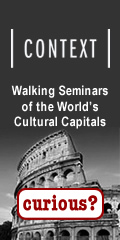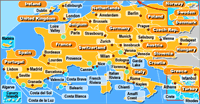Istria trip planner
The heart-shaped peninsula at the top of the Adriatic Sea is a bit Croatia, a bit Slovenia, a bit Italian, a bit Austrian, a bit ancient Roman... and all Istrian
Istria: Italy, with a Slavic accent
From Zagreb, strike out west to the Istrian Peninsula (www.istra.hr). As a legacy of centuries when this coast was part of the Republic of Venice, Istria's string of castle-topped fishing towns recall the Italian Riviera in the era before mass tourism ruined them, and the catch-of-the-day costs $10 at dockside restaurants.
Poreč's (www.istra.com/porec) sixth-century basilica glitters with golden mosaic—and its streets teem with Italian and Germans on week-long sun-sizzling beach vacations. ![]()
That why I prefer the next major stop down the coast, Rovinj (www.tzgrovinj.hr), a compact town straight out of the Middle Ages. It has its share of tourists, too, but they don't quite overwhelm the place. ![]()
Pula (www.pulainfo.hr), near the southern tip of the peninsula, remains so Roman in character its ancient forum still serves as the main town square and its 2,000-year-old Arena rivals Rome's Colosseum as one of the world's best-preserved ancient amphitheaters and continues to host open-air spectacles in the summertime (though they've moved on from bloody gladiator battles to concerts and operas). ![]()
Inland Istria is still a heavily forested land peppered by tiny vineyards and farm fields. It remains (for now) gloriously ignored by 90% of the tourists who flock to the coast, leaving intrepid travelers plenty of room to enjoy its red Teran and white Malvasija wines (and the mistletoe-flavored rakija brandy, a dangerously potent grappa), its magnificent white truffles, and the sweeping panoramas from its medieval hilltop villages. ![]()
Many of these towns are (or were) half-abandoned and now serve as artist communities.
Other villages hide unassuming little Romanesque chapels (get the kljuc, the key, from the little old lady who lives on the main village square; anyone can point her out) that are swathed inside with 15th century Gothic frescoes. Alongside the usual Bible scene themes are such wonderfully earthy touch as representations of the months of the year (according to a peasant's calendar of sowing, reaping, stomping grapes, and surviving the winter), and, my personal favorite, the Dance of Death, in which a conga line of skeletons leads a procession of people—ranging from beggar and solider to monk and cardinal to king and pope—to their inevitable earthly grave (look for the banker character somewhere in the middle; he's usually tying to bribe his skeleton to try and get out of dying).
For my full story "In Search of Istria," click here. ![]()
Related Articles |
Outside Resources |
This article was last updated in January 2010. All information was accurate at the time.
Copyright © 1998–2010 by Reid Bramblett. Author: Reid Bramblett.



 ShareThis
ShareThis


